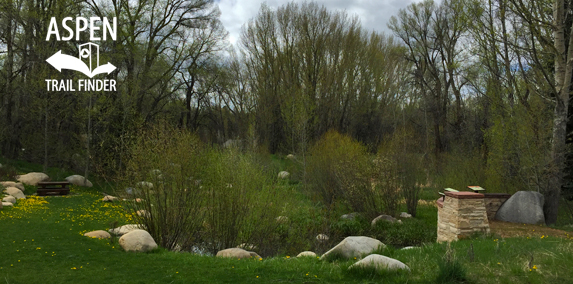Connects: Rio Grande Trail, Aspen Center for Environmental Studies (ACES)

Jennie Adair Sawmill Park in Aspen
Aspen, CO – Park
Jennie Adair Sawmill Park is an open space and wetlands along the Rio Grande Trail near the Aspen Post Office in Aspen, CO. This park includes:
Wetlands
Hallam Lake
Named in honor of Jennie Adair, pioneer logger and sawmill operator. Died – July 4, 1937
Steam boiler used by her on this site. Dedicated August 27, 1977″
This wetland project is named for a spirited, early Aspen resident who ran a sawmill on this site.
Jennie Adair and her husband settled in the Hunter Creek Valley above Aspen in the early 1880s. The hard-working couple cut timber and milled lumber to supply the booming silver mining district. After her husband died in an accident in 1889, Jennie kept on logging and running the sawmill by herself.
In 1899, Jennie moved her sawmill to Aspen and continued hands-on operation until 1925.”
Aspen straddles several tributaries of the Roaring Fork, one of Colorado’s few remaining wild rivers, and a world-class fishery. The impacts we have on the streams and rivers that flow through our community affect water quality, natural systems, and our neighbors downstream.
Who needs clean water?
We all do! The Roaring Fork creates critical habitat for wildlife, provides irrigation water for farms and ranches, and offers outstanding recreational opportunities.
What’s the problem?
Untreated snowmelt and storm runoff can pollute rivers and streams. Water from melting snow and rainstorms picks up trash, debris, silt, motor oil, and other pollutants as it flows over our streets, parking lots, and lawns. Dirty water runs down street drains and through storm sewers that empty into our river.
The wetlands project you see here was created to help keep the Roaring Fork River clean. The City of Aspen and the Aspen Center for Environmental Studies combined their efforts and resources to make this project a great success.”
The Jennie Adair Wetlands project uses engineered and natural systems to improve the quality of water flowing into the Roaring Fork River from our city’s storm sewers.
How does it work?
Runoff from street drains collect in large, underground vaults. The vaults trap dirt, debris, and trash, and filter out some pollutants like oil and grease.
Water from the vault flows through a pipe below this wall and out over the wetland.
Plants are the key to clean water
Plants in this marshy, upper portion of the wetland slow the runoff coming from the vault. This gives silt in the water time to settle out.
Plants also go to work on heavy metals, nitrates, and other pollutants in runoff water. Plants absorb the contaminants, using some for food and locking others in their tissues.
By the time runoff makes its way across the upper wetlands and through the lower-level pond, it’s clean enough to join the fresh waters of the Roaring Fork.”
Jennie Adair Wetlands is a large storm water wetland control area. This large parcel attracts many different species of wildlife throughout the year. On the southern edge of the park is a small grass lawn with a few picnic tables. If you venture further into the property you will find a walking trail with interpretive signage explaining the history of the site.”
























